Multispectral Analysis of Small Plots Based on Field and Remote Sensing Surveys—A Comparative Evaluation
Abstract
:1. Introduction
2. Materials and Methods
2.1. Soil Characteristics of the Experimental Site
2.2. Weather Characteristics of the Experiment Year
2.3. Experiment Setup
- Control, without foliar fertilization.
- Silicon fertilization (Si) 3.0 L ha−1.
- Sulfur fertilization (S) 5.0 L ha−1.
- Silicon+Sulfur fertilization (Si+S) 3.0+5.0 L ha−1.
- Sulfur fertilizer: liquid foliar fertilizer with a high Sulfur content (lignosulfonate formulation) 1000 g L−1 SO3, 30 g L−1 N, 30 g L−1 MgO, 27 g L−1 B, 0.003 g L−1 Mo.
- Silicon fertilizer: (potassium silicate formulation) 1.4 m/m% Si, 10.5 m/m% K2O.
| 1 December 2020 | BBCH13 (3 leaves unfolded) |
| 10 May 2021 | BBCH39 (flag leaf stage) |
| 18 June 2021 | BBCH73 (early milk) |
2.4. Measurements, Calculations and Their Methodology
2.4.1. Field Measurements
2.4.2. UAV Based Measurements
2.4.3. Laboratory Measurements
2.5. Data Analysis
3. Results
3.1. Elevation and Soil pH
3.2. Effects of Treatments on the Chlorophyll Content and SPAD Value of Oat
3.3. NDVI Field and UAV Measurements
3.4. Discriminant Analysis
4. Discussion
5. Conclusions
Author Contributions
Funding
Institutional Review Board Statement
Informed Consent Statement
Conflicts of Interest
References
- Stevens, E.J.; Armstrong, K.W.; Bezar, H.J.; Griffin, W.B.; Hampton, J.G. Chapter II—Fodder Oats: An Overview. In Fodder Oats: A World Overview; Suttie, J.M., Reynolds, S.G., Eds.; FAO Plant Production and Protection Series No.33; Food and Agriculture Organization of the United Nations: Rome, Italy, 2004; p. 251. ISBN 92-5-105243-3. [Google Scholar]
- EUROSTAT. apro_cpnh1. 2021. Available online: http://appsso.eurostat.ec.europa.eu/nui/submitViewTableAction.do (accessed on 16 December 2021).
- Sawasawa, H.L.A. Crop Yield Estimation: Integrating RS, GIS, and Management Factors. A Case Study of Birkoor and Kortigiri Mandals, Nizamabad District India. Master’s Thesis, International Institute for Geo-Information Science and Earth Observation, Enschede, The Netherlands, March 2003. [Google Scholar]
- Bartholy, J.; Barcza, Z.; Bihari, Z.; Czira, T.; Haszpra, L.; Horányi, A.; Horváth, E.S.; Krüzselyi, I.; Lakatos., M.; Mészáros, R.; et al. Klímaváltozás. Klímaszcenáriók a Kárpát-medence térségére. Országos Meteorológiai vizsgálat. (Climate Change, Climate Scenarios in Carpathian Basin Region. National Meteorological Study); Hungarian Academy of Sciences and Eötvös Lóránd University: Budapest, Hungary, 2011. (In Hungarian) [Google Scholar]
- Juhász, C.; Gálya, B.; Kovács, E.; Nagy, A.; Tamás, J.; Huzsvai, L. Seasonal predictability of weather and crop yield in regions of Central European continental climate. Comput. Electron. Agric. 2020, 173, 105400. [Google Scholar] [CrossRef]
- Szász, G. Termésingadozást kiváltó éghajlati változékonyság a Kárpát-medencében. (Yield fluctuation caused by climatic variability in Carpathian Basin). Agro-21 füzetek 2005, 40, 33–69. (In Hungarian) [Google Scholar]
- Prince, S.D. A model of regional primary production for use with coarse resolution satellite data. Int. J. Remote Sens. 1991, 12, 1313–1330. [Google Scholar] [CrossRef]
- Baret, F.; Guyot, G. Potentials and limits of vegetation indices for LAI and APAR assessment. Remote Sens. Environ. 1991, 35, 161–173. [Google Scholar] [CrossRef]
- Bolton, D.K.; Friedl, M.A. Forecasting crop yield using remotely sensed vegetation indices and crop phenology metrics. Agric. For. Meteorol. 2013, 173, 74–84. [Google Scholar] [CrossRef]
- Panda, S.S.; Ames, D.P.; Panigrahi, S. Application of vegetation indices for agricultural crop yield prediction using neural network techniques. Remote Sens. 2010, 2, 673–696. [Google Scholar] [CrossRef] [Green Version]
- Dempewolf, J.; Adusei, B.; Becker-Reshef, I.; Hansen, M.; Potapov, P.; Khan, A.; Barker, B. Wheat yield forecasting for Punjab Province from vegetation index time series and historic crop statistics. Remote Sens. 2014, 6, 9653–9675. [Google Scholar] [CrossRef] [Green Version]
- Mkhabela, M.S.; Bullock, P.; Raj, S.; Wang, S.; Yang, Y. Crop yield forecasting on the Canadian Prairies using MODIS NDVI data. Agric. For. Meteorol. 2011, 151, 385–393. [Google Scholar] [CrossRef]
- de la Casa, A.; Ovando, G.; Bressanini, L.; Martínez, J.; Díaz, G.; Miranda, C. Soybean crop coverage estimation from NDVI images with different spatial resolution to evaluate yield variability in a plot. ISPRS J. Photogramm. Remote Sens. 2018, 146, 531–547. [Google Scholar] [CrossRef]
- Pullanagari, R.R.; Yule, I.; King, W.; Dalley, D.; Dynes, R. The use of optical sensors to estimate pasture quality. Int. J. Smart Sens. Intell. Syst. 2011, 4, 125–137. [Google Scholar] [CrossRef] [Green Version]
- Pallottino, F.; Antonucci, F.; Costa, C.; Bisagli, C.; Figorilli, S.; Menesatti, P. Optoelectronic proximal sensing vehicle-mounted technologies in precision agriculture: A review. Comput. Electron. Agric. 2019, 162, 859–873. [Google Scholar] [CrossRef]
- Modica, G.; Messina, G.; De Luca, G.; Fiozzo, V.; Praticò, S. Monitoring the vegetation vigor in heterogeneous citrus and olive orchards.A multiscale object-based approach to extract trees’crowns from UAV multispectral imagery. Comput. Electron. Agric. 2020, 175, 105500. [Google Scholar] [CrossRef]
- Riczu, P.; Nagy, A.; Tamás, J.; Lehoczky, É. Precision weed detection using terrestrial laser scanning techniques. Commun. Soil Sci. Plant Anal. 2015, 46, 309–316. [Google Scholar] [CrossRef] [Green Version]
- Frew, A.; Weston, L.A.; Reynolds, O.L.; Gurr, G.M. The role of silicon in plant biology: A paradigm shift in research approach. Ann. Bot. 2018, 121, 1265–1273. [Google Scholar] [CrossRef] [PubMed] [Green Version]
- Kutasy, E.; Buday-Bódi, E.; Virág, I.C.; Forgács, F.; Melash, A.A.; Zsombik, L.; Nagy, A.; Csajbók, J. Mitigating the Negative Effect of Drought Stress in Oat (Avena sativa L.) with Silicon and Sulphur Foliar Fertilization. Plants 2022, 11, 30. [Google Scholar] [CrossRef] [PubMed]
- Bhat, J.A.; Shivaraj, S.M.; Singh, P.; Navadagi, D.B.; Tripathi, D.K.; Dash, P.K.; Solanke, A.U.; Sonah, H.; Deshmukh, R. Role of Silicon in Mitigation of Heavy Metal Stresses in Crop Plants. Plants 2019, 8, 71. [Google Scholar] [CrossRef] [Green Version]
- Ning, D.; Song, A.; Fan, F.; Li, Z.; Liang, Y. Effects of slag-based silicon fertilizer on rice growth and brown-spot resistance. PLoS ONE 2014, 9, e102681. [Google Scholar] [CrossRef] [PubMed] [Green Version]
- Villegas, J.M.; Way, M.O.; Pearson, R.A.; Stout, M.J. Integrating Soil Silicon Amendment into Management Programs for Insect Pests of Drill-Seeded Rice. Plants 2017, 6, 33. [Google Scholar] [CrossRef] [Green Version]
- Yu, Z.; She, M.; Zheng, T.; Diepeveen, D.; Islam, S.; Zhao, Y.; Zhang, Y.; Tang, G.; Zhang, Y.; Zhang, J.; et al. Impact and mechanism of sulphur-deficiency on modern wheat farming nitrogen-related sustainability and gliadin content. Commun. Biol. 2021, 4, 945. [Google Scholar] [CrossRef]
- Zenda, T.; Liu, S.; Dong, A.; Duan, H. Revisiting Sulphur—The Once Neglected Nutrient: It’s Roles in Plant Growth, Metabolism, Stress Tolerance and Crop Production. Agriculture 2021, 11, 626. [Google Scholar] [CrossRef]
- Tewkesbury, A.P.; Comber, A.J.; Tate, N.J.; Lamb, A.; Fisher, P.F. A critical synthesis of remotely sensed optical image change detection techniques. Remote Sens. Environ. 2015, 160, 1–14. [Google Scholar] [CrossRef] [Green Version]
- Vicente-Serrano, S.M.; Cabello, D.; Tomás-Burguera, M.; Martín-Hernández, N.; Beguería, S.; Azorin-Molina, C.; Kenawy, A.E. Drought variability and land degradation in semiarid regions: Assessment using remote sensing data and drought indices (1982–2011). Remote Sens. 2015, 7, 4391–4423. [Google Scholar] [CrossRef] [Green Version]
- Atzberger, C. Advances in remote sensing of agriculture: Context description, existing operational monitoring systems and major information needs. Remote Sens. 2013, 5, 949–981. [Google Scholar] [CrossRef] [Green Version]
- Tamás, J.; Nagy, A.; Fehér, J. Agricultural biomass monitoring on watersheds based on remotely sensed data. Water Sci. Technol. 2015, 72, 2212–2220. [Google Scholar] [CrossRef] [PubMed]
- Nagy, A.; Szabó, A.; Adeniyi, O.D.; Tamás, J. Wheat Yield Forecasting for the Tisza River Catchment Using Landsat 8 NDVI and SAVI Time Series and Reported Crop Statistics. Agronomy 2021, 11, 652. [Google Scholar] [CrossRef]
- Clement, S.; Lassman, F.; Barley, E.; Evans-Lacko, S.; Williams, P.; Yamaguchi, S.; Slade, M.; Rüsch, N.; Thornicroft, G. Mass media interventions for reducing mental health-relatedstigma (Review). Cochrane Libr. 2013, 23, CD009453. [Google Scholar]
- USS Working Group WRB. World Reference Base for Soil Resources 2014, International Soil Classification System for Naming Soils and Creating Legends for Soil Maps; World Soil Resources Reports; FAO: Rome, Italy, 2015. [Google Scholar]
- Konica Minolta. Available online: https://www5.konicaminolta.eu/fileadmin/content/eu/Measuring_Instruments/2_Products/1_Colour_Measurement/6_Chlorophyll_Meter/PDF/Spad502plus_EN.pdf (accessed on 22 January 2022).
- Meier, U. Growth Stages of Mono and Dicotyledonous Plants, BBCH Monograph; Julius Kühn-Institut (JKI): Quedlinburg, Germany, 2018. [Google Scholar] [CrossRef]
- Rouse, W.J.; Haas, R.H.; Schell, J.A.; Deering, D.W. Monitoring Vegetation Systems in the Great Plains with ERTS. In Proceedings of the Third ERTS Symposium, Washington, DC, USA, 10–14 December 1973; pp. 309–317. [Google Scholar]
- Sentera. 2021. Available online: https://support.sentera.com/portal/en/kb/sentera (accessed on 21 January 2022).
- Szabó, A.; Tamás, J.; Nagy, A. The influence of hail net on the water balance and leaf pigment content of apple orchards. Sci. Hortic. 2021, 283, 110112. [Google Scholar] [CrossRef]
- Droppa, M.; Erdei, S.; Horváth, G.; Kissimom, J.; Mészáros, A.; Szalai, J.; Kosáry, J. Növénybiokémiai és élettani gyakorlatok (Plant Biochemistry and Physiology Practices); Budapest University of Economic Sciences and Public Administration: Budapest, Hungary, 2003; p. 88. (In Hungarian) [Google Scholar]
- Olesen, J.; Trnka, M.; Kersebaum, K.; Peltonen-Sainio, P.; Rossi, F.; Kozyra, J.; Micale, F.; Seguin, B.; Skjelvåg, A. Impacts and adaptation of European crop production systems to climate change. Eur. J. Agron. 2011, 34, 96–112. [Google Scholar] [CrossRef]
- Hatfield, J.L.; Prueger, J.H. Value of Using Different Vegetative Indices to Quantify Agricultural Crop Characteristics at Different Growth Stages under Varying Management Practices. Remote Sens. 2010, 2, 562–578. [Google Scholar] [CrossRef] [Green Version]
- Mielke, M.; Schaffer, B.; Li, C. Use of a SPAD meter to estimate chlorophyll content in Eugenia uniflora L. leaves as affected by contrasting light environments and soil flooding. Photosynthetica 2010, 48, 332–338. [Google Scholar] [CrossRef]
- Zandonadi, C.H.S.; Albuquerque, C.J.B.; de Freitas, R.S. Chlorophyll index (SPAD) and macronutrients relation and productive performance of sorghum hybrids in different sowing dates. Aust. J. Crop. Sci. 2016, 10, 546–555. [Google Scholar] [CrossRef]
- Żelazny, W.R. Application of feature selection for predicting leaf chlorophyll content in oats (Avena sativa L.) from hyperspectral imagery. Agron. Res. 2020, 18, 2665–2676. [Google Scholar] [CrossRef]
- Shah, J.; Wang, X.; Khan, S.U.; Khan, S.; Gurmani, Z.A.; Fiaz, S.; Qayyum, A. Optical-Sensor-Based Nitrogen Management in Oat for Yield Enhancement. Sustainability 2021, 13, 6955. [Google Scholar] [CrossRef]
- Kizilgeci, F.; Yildirim, M.; Islam, M.S.; Ratnasekera, D.; Iqbal, M.A.; Sabagh, A.E. Normalized Difference Vegetation Index and Chlorophyll Content for Precision Nitrogen Management in Durum Wheat Cultivars under Semi-Arid Conditions. Sustainability 2021, 13, 3725. [Google Scholar] [CrossRef]
- Öner, F. Assessment of genetic variation in Turkish local maize genotypes using multivariate discriminant analysis. Appl. Ecol. Environ. Res. 2018, 16, 1369–1380. [Google Scholar] [CrossRef]
- Bégué, A.; Arvor, D.; Bellon, B.; Betbeder, J.; De Abelleyra, D.; Ferraz, R.P.D.; Lebourgeois, V.; Lelong, C.; Simões, M.; Verón, S.R. Remote Sensing and Cropping Practices: A Review. Remote Sens. 2018, 10, 99. [Google Scholar] [CrossRef] [Green Version]
- Rascio, A.; Carlino, E.; De Santis, G.; Di Fonzo, N. A Discriminant Analysis to Categorize Durum Wheat Varieties in Drought-tolerance Classes on the Basis of Rheological and Physiological Traits. Cereal Res. Commun. 2013, 41, 88–96. Available online: http://www.jstor.org/stable/23792259 (accessed on 26 January 2022). [CrossRef]
- Chivasa, W.; Mutanga, O.; Biradar, C. Phenology-based discrimination of maize (Zea mays L.) varieties using multitemporal hyperspectral data. J. Appl. Rem. Sens. 2019, 13, 017504. [Google Scholar] [CrossRef]
- Zhang, H.; Hinze, L.L.; Lan, Y.; Westbrook, J.K.; Hoffmann, W.C. Discriminating among Cotton Cultivars with Varying Leaf Characteristics Using Hyperspectral Radiometry. Trans. ASABE 2012, 55, 275–280. [Google Scholar] [CrossRef]
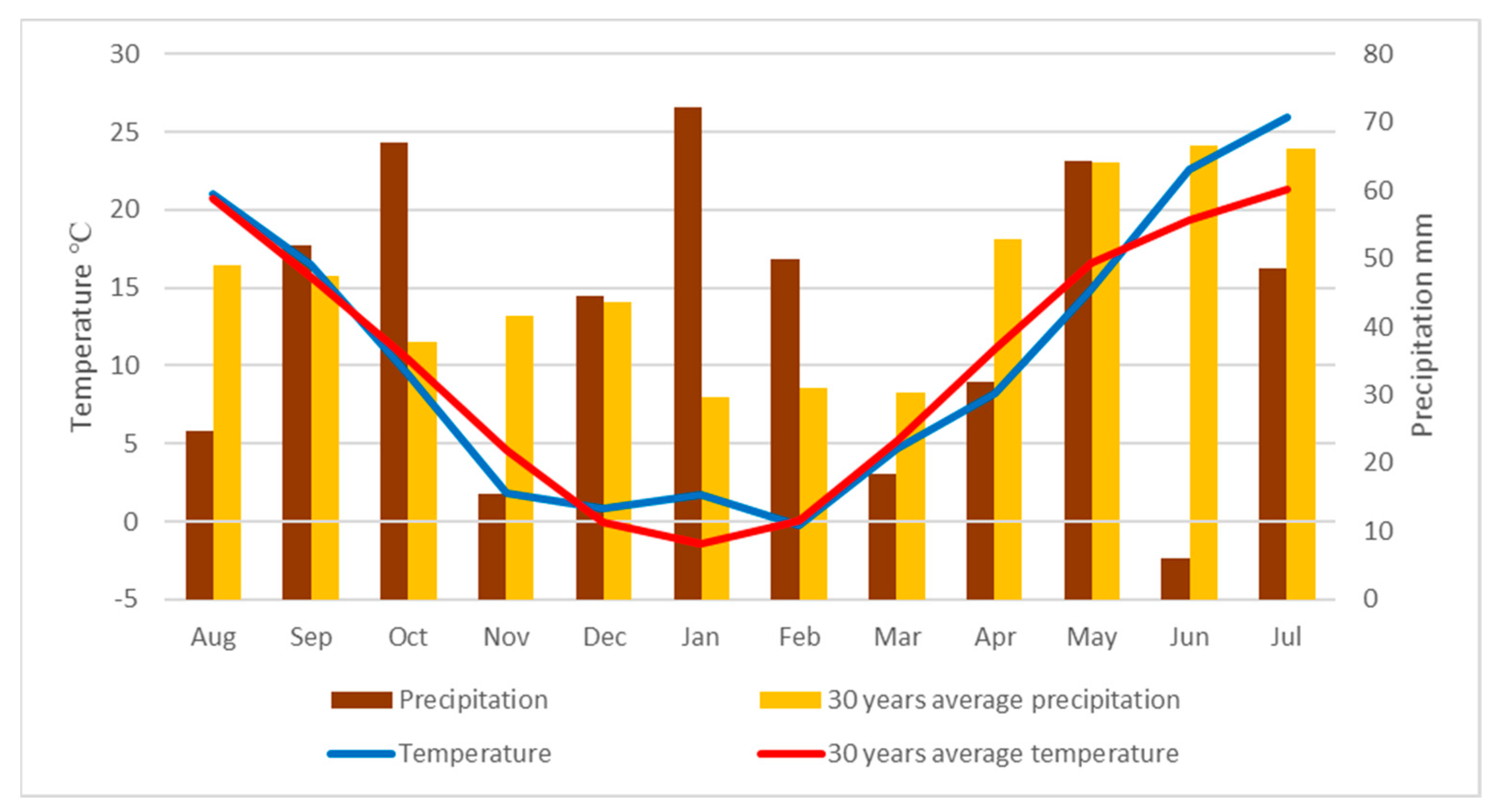

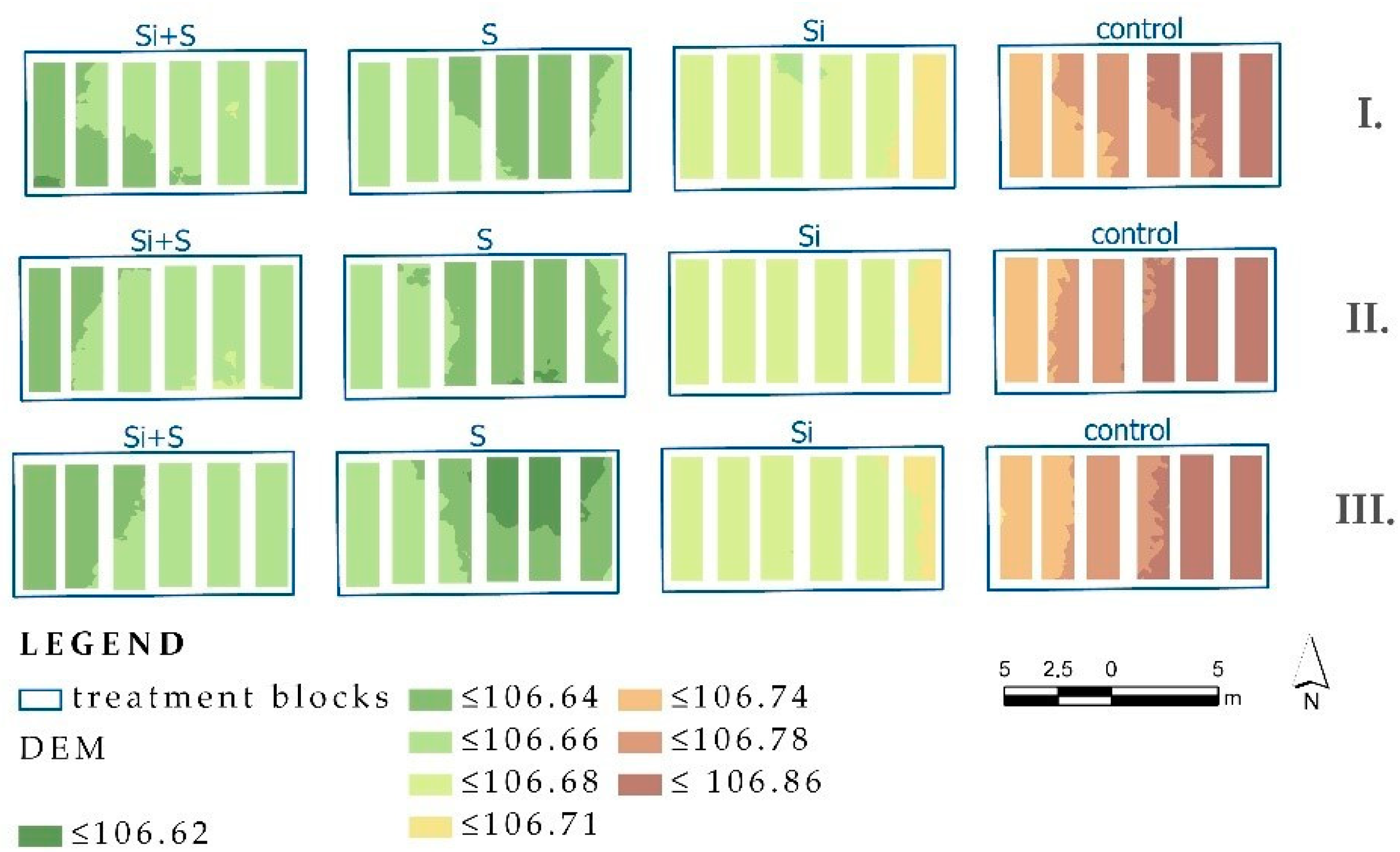

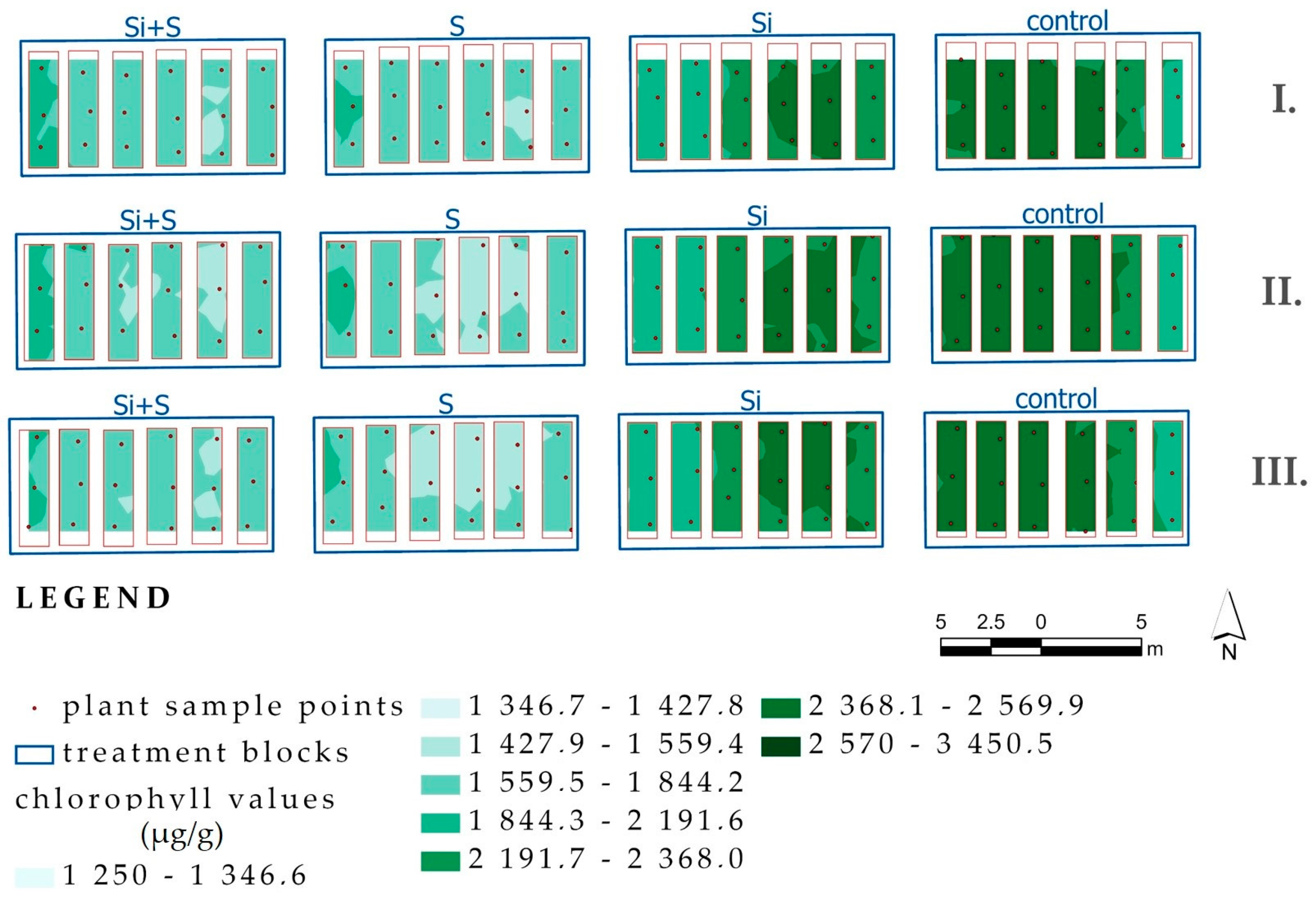



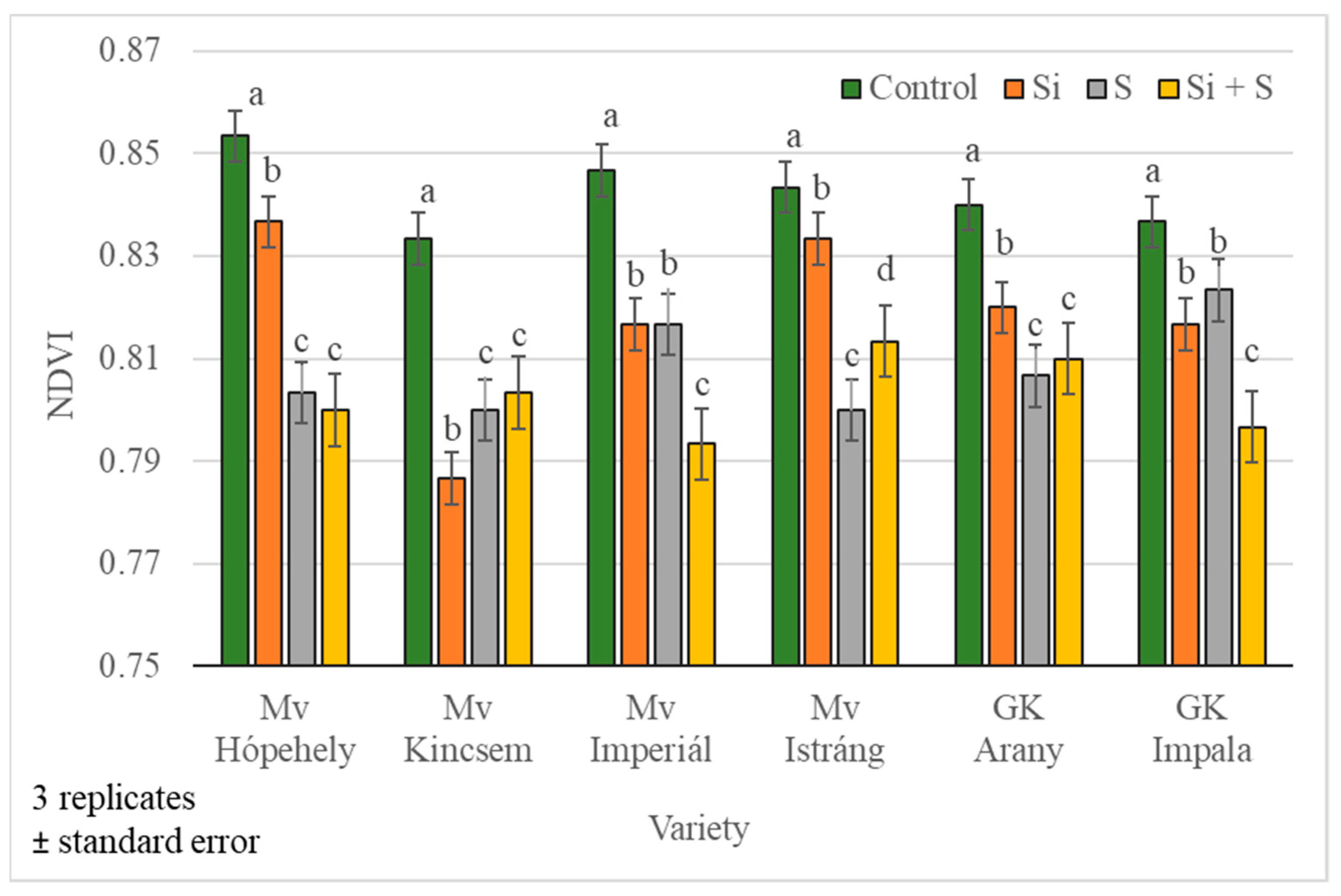
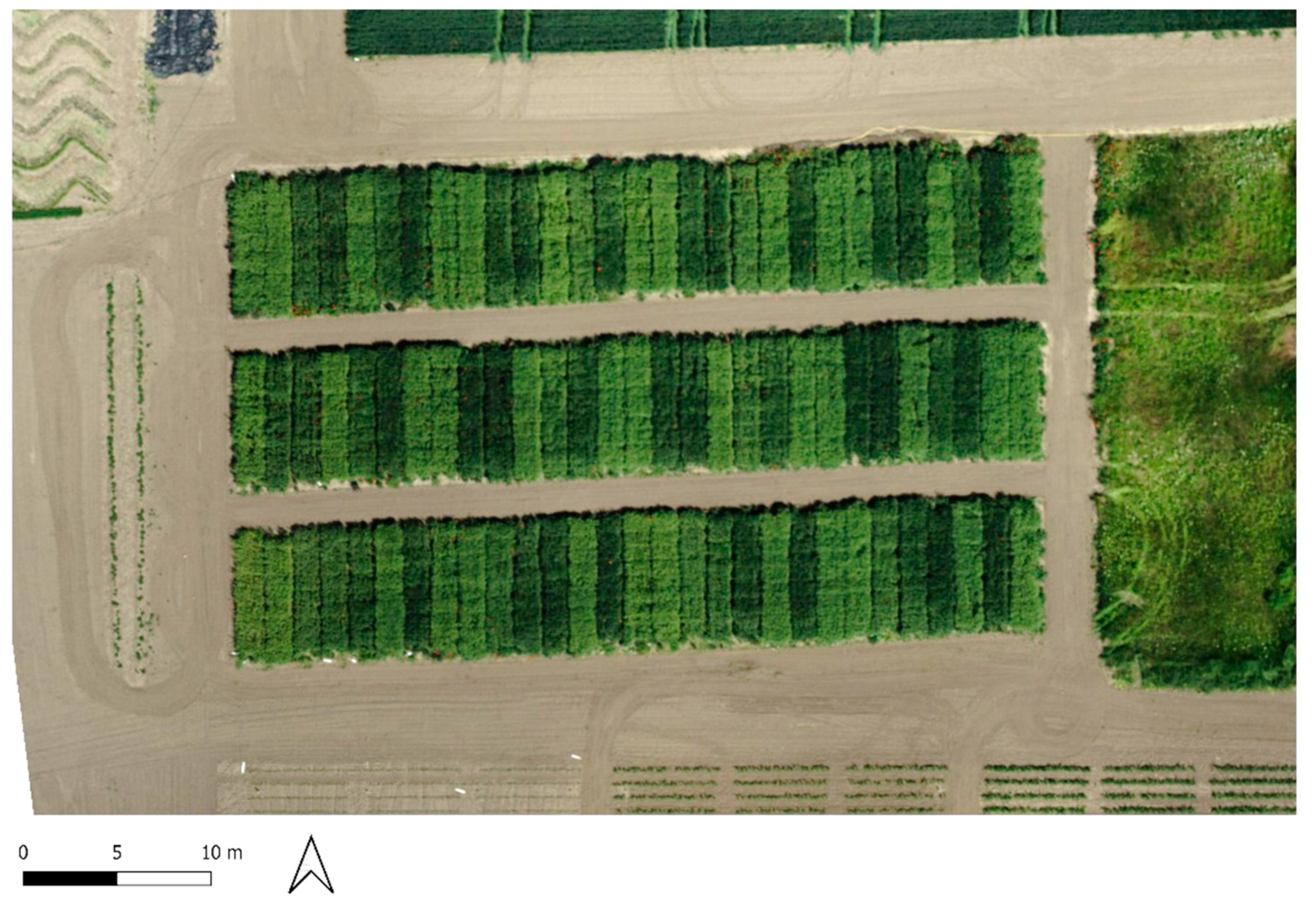

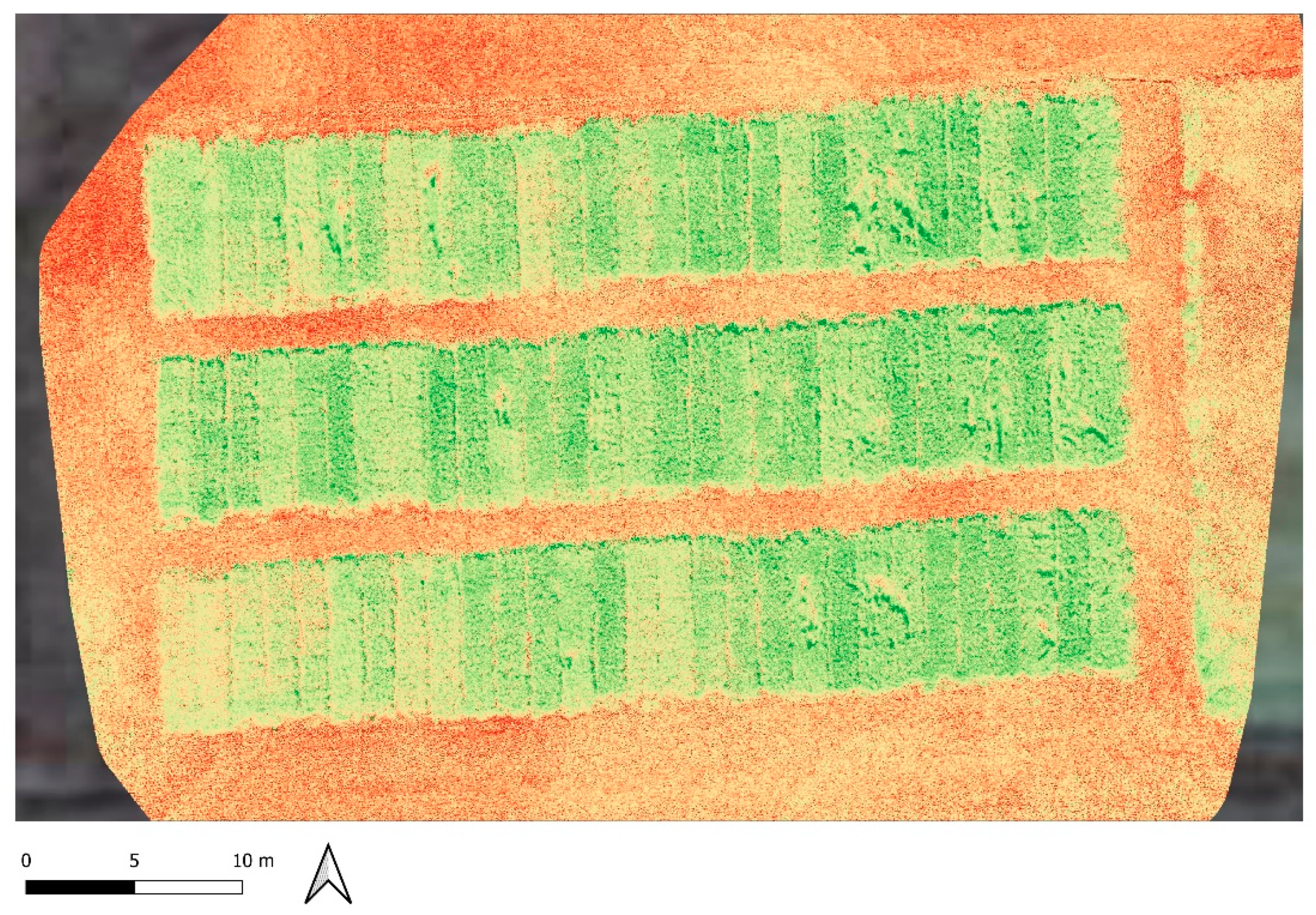
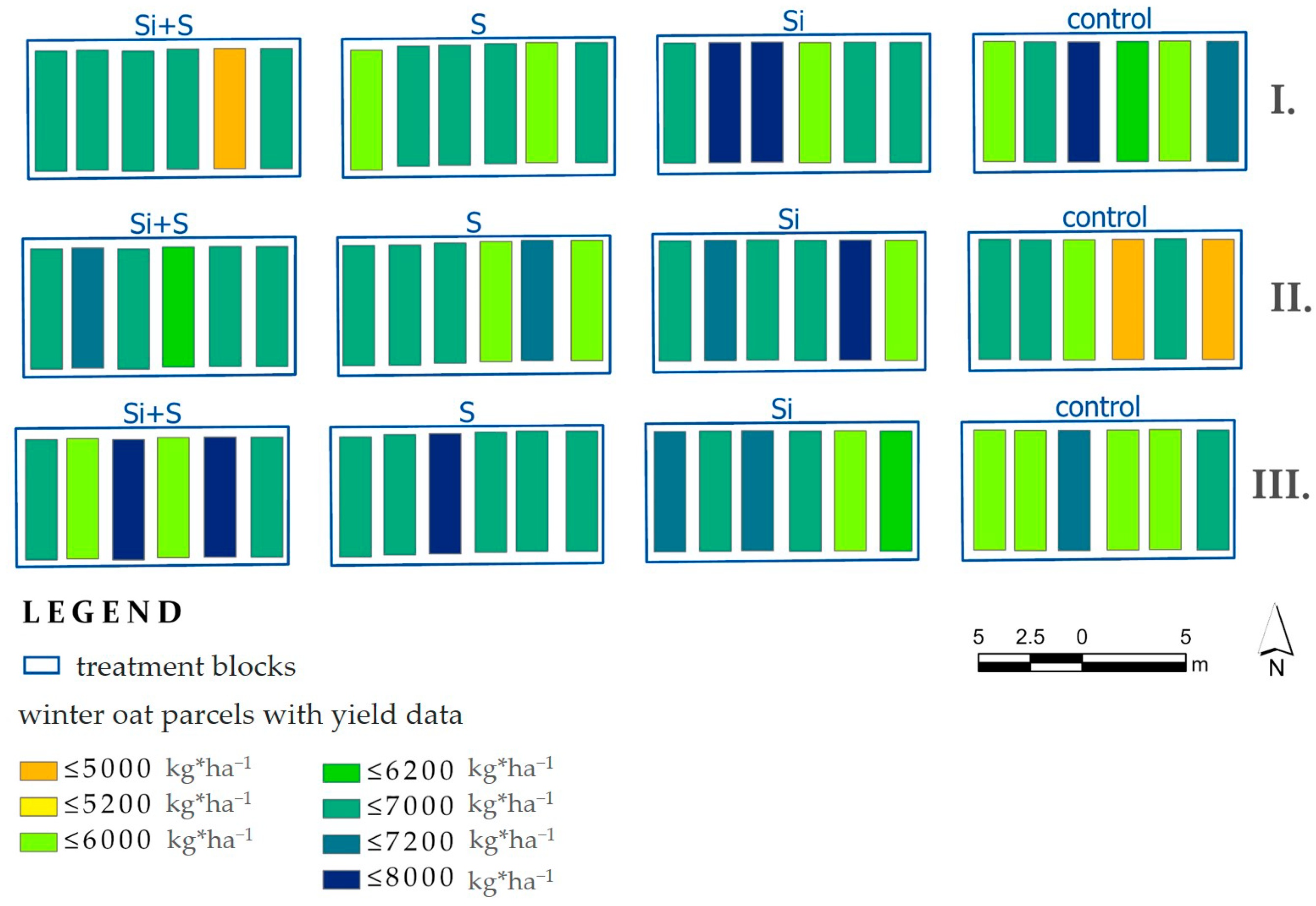
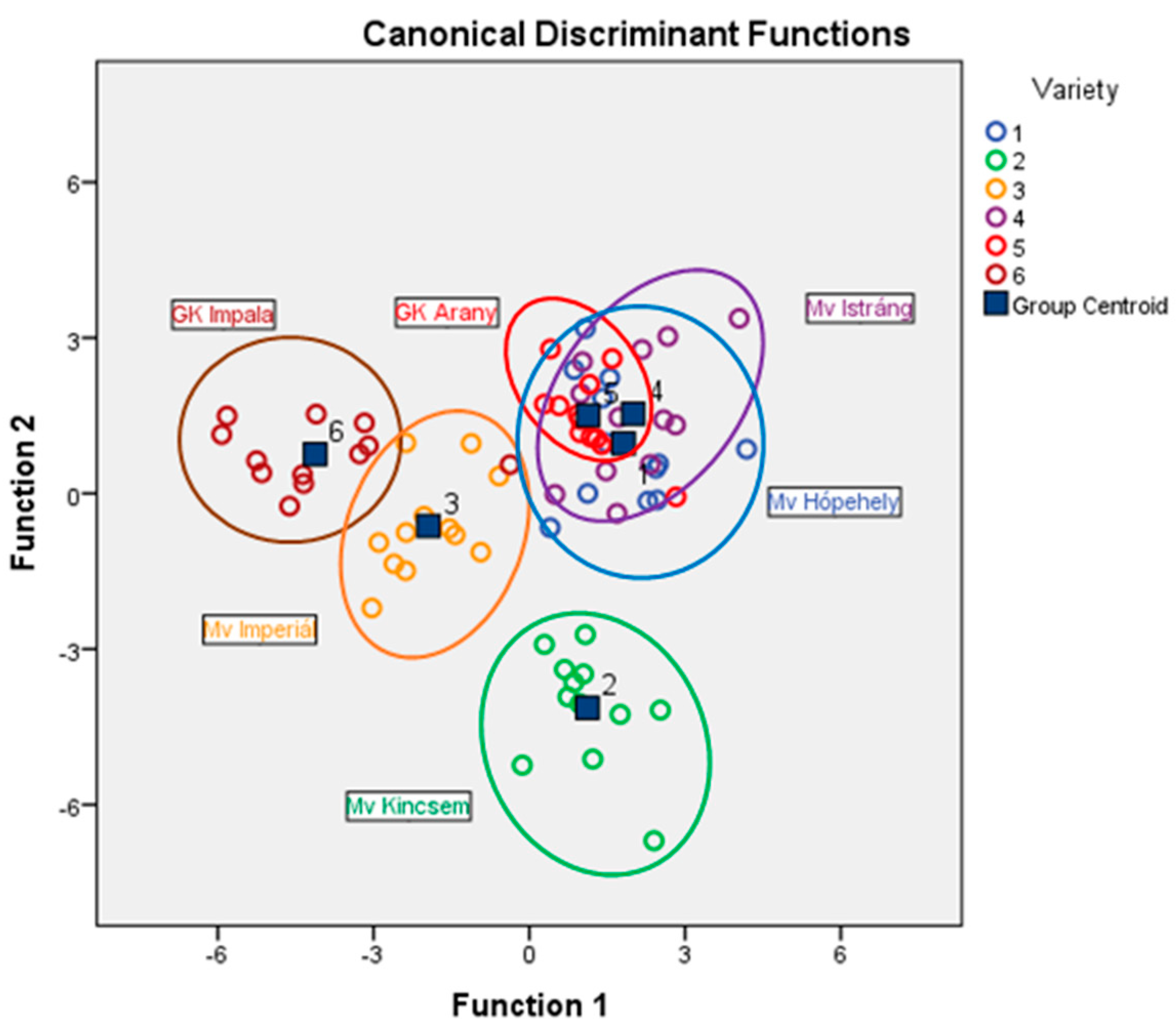
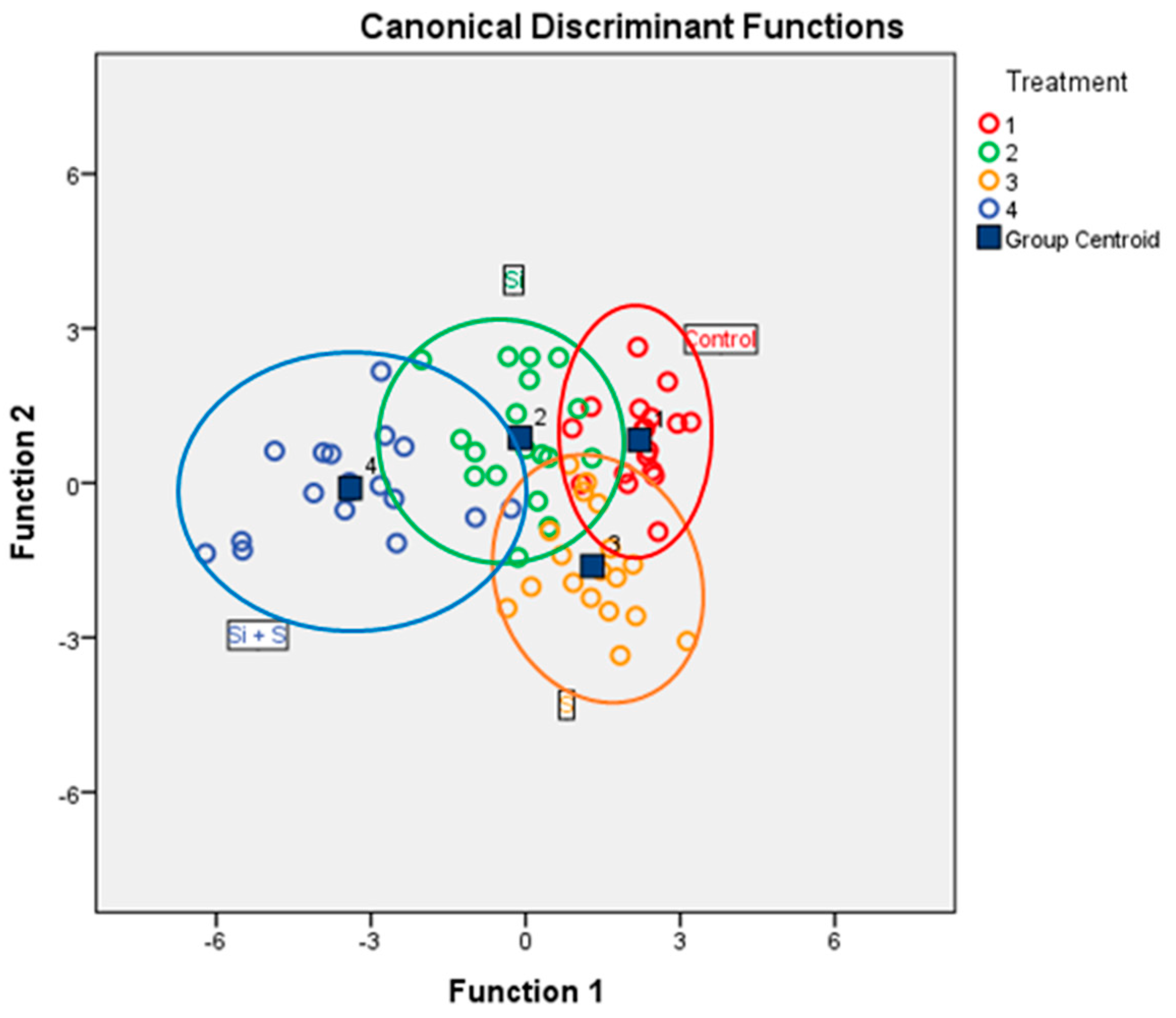
| Layer 0–20 cm | Layer 20–40 cm | Layer 40–60 cm | |
|---|---|---|---|
| pH (H2O) | 8.30 | 8.36 | 8.43 |
| KA | 38 | 38 | 38 |
| CaCO3 (%) | 8.1 | 8.1 | 8.1 |
| Humus (%) | 3.66 | 2.92 | 2.70 |
| NO3+NO2 (mg kg−1) | 1.71 | 2.95 | 3.18 |
| NH4 (mg kg−1) | 0.836 | 1.023 | 3.180 |
| P2O5 (AL) (mg kg−1) | 1671.6 | 1376.1 | 1076.8 |
| K2O (AL) (mg kg−1) | 658.9 | 648.2 | 525.5 |
| SO4 (mg kg−1) | 3.07 | 6.00 | 7.81 |
| Chlorophyll Content | pH | SPAD1 | SPAD2 | SPAD3 | |
|---|---|---|---|---|---|
| Chlorophyll content | 1 | −0.304 | −0.059 | −0.216 | 0.011 |
| pH | −0.304 | 1 | −0.071 | 0.208 | −0.162 |
| NDVI1 | NDVI2 | NDVI3 | NDVI4 | NDVI5 | NDRE2 UAV | NDRE3 UAV | NDRE4 UAV | NDRE5 UAV | |
|---|---|---|---|---|---|---|---|---|---|
| NDVI2 | 0.683 ** | - | 0.210 | 0.548 ** | 0.469 ** | 0.517 ** | 0.516 ** | 0.236 * | 0.458 ** |
| NDVI3 | 0.270 * | 0.210 | - | 0.455 ** | 0.090 | 0.064 | 0.256 | 0.172 | 0.102 |
| NDVI4 | 0.427 ** | 0.548 ** | 0.455 ** | - | 0.569 ** | 0.431 ** | 0.529 ** | 0.213 | 0.296 * |
| NDVI5 | 0.360 ** | 0.469 ** | 0.090 | 0.569 ** | - | 0.424 ** | 0.489 ** | 0.247 * | 0.388 ** |
| NDRE2UAV | 0.389 ** | 0.517 ** | 0.064 | 0.431 ** | 0.424 ** | - | 0.809 ** | 0.389 ** | 0.742 ** |
| NDRE3UAV | 0.390 ** | 0.516 ** | 0.256 | 0.529 ** | 0.489 ** | 0.809 ** | - | 0.495 ** | 0.594 ** |
| NDRE4UAV | 0.035 | 0.236 * | 0.172 | 0.213 | 0.247 * | 0.389 ** | 0.495 ** | - | 0.555 ** |
| NDRE5UAV | 0.248 * | 0.458 ** | 0.102 | 0.296 * | 0.388 ** | 0.742 ** | 0.594 ** | 0.555 ** | - |
| NDVI1UAV | 1.000 ** | 0.683 ** | 0.270 * | 0.427 ** | 0.360 ** | 0.389 ** | 0.390 ** | 0.035 | 0.248 * |
| NDVI2UAV | 0.682 ** | 0.988 ** | 0.203 | 0.590 ** | 0.495 ** | 0.548 ** | 0.555 ** | 0.235 * | 0.491 ** |
| NDVI3UAV | 0.539 ** | 0.516 ** | 0.700 ** | 0.764 ** | 0.464 ** | 0.402 ** | 0.506 ** | 0.120 | 0.204 |
| NDVI4UAV | 0.423 ** | 0.562 ** | 0.398 ** | 0.968 ** | 0.571 ** | 0.470 ** | 0.579 ** | 0.216 | 0.330 ** |
| NDVI5UAV | 0.279 * | 0.443 ** | 0.157 | 0.415 ** | 0.895 ** | 0.352 ** | 0.419 ** | 0.242 * | 0.329 ** |
| SPAD1 | SPAD2 | SPAD3 | |
|---|---|---|---|
| NDVIUAV1 | 0.142 | 0.195 | 0.437 ** |
| NDVIUAV2 | 0.337 ** | 0.226 | 0.352 ** |
| NDVIUAV3 | 0.033 | 0.017 | 0.031 |
| NDVIUAV4 | 0.456 ** | 0.147 | 0.382 ** |
| NDVIUAV5 | 0.601 ** | 0.350 ** | 0.452 ** |
| NDRE2UAV | 0.457 ** | 0.262 * | 0.280 * |
| NDRE3UAV | 0.485 ** | 0.190 | 0.282 * |
| NDRE4UAV | 0.284 * | 0.022 | 0.057 |
| NDRE5UAV | 0.337 ** | 0.151 | 0.243 * |
| Variety | Predicted Group Membership | |||||
|---|---|---|---|---|---|---|
| 1 | 2 | 3 | 4 | 5 | 6 | |
| 1 | 66.7% | 0% | 0% | 25% | 8.3% | 0% |
| 2 | 0% | 100% | 0% | 0% | 0% | 0% |
| 3 | 0% | 0% | 100% | 0% | 0% | 0% |
| 4 | 16.7% | 0% | 0% | 83.3% | 0% | 0% |
| 5 | 8.3% | 0% | 0% | 0% | 91.7% | 0% |
| 6 | 8.3% | 0% | 0% | 0% | 0% | 91.7% |
| Treatment | Predicted Group Membership | |||
|---|---|---|---|---|
| Control | Si | S | Si+S | |
| Control | 88.9% | 5.6% | 5.6% | 0% |
| Si | 5.6% | 83.3% | 11.1% | 0% |
| S | 5.6% | 11.1% | 83.3% | 0% |
| Si+S | 0% | 5.6% | 0% | 94.4% |
Publisher’s Note: MDPI stays neutral with regard to jurisdictional claims in published maps and institutional affiliations. |
© 2022 by the authors. Licensee MDPI, Basel, Switzerland. This article is an open access article distributed under the terms and conditions of the Creative Commons Attribution (CC BY) license (https://creativecommons.org/licenses/by/4.0/).
Share and Cite
Csajbók, J.; Buday-Bódi, E.; Nagy, A.; Fehér, Z.Z.; Tamás, A.; Virág, I.C.; Bojtor, C.; Forgács, F.; Vad, A.M.; Kutasy, E. Multispectral Analysis of Small Plots Based on Field and Remote Sensing Surveys—A Comparative Evaluation. Sustainability 2022, 14, 3339. https://doi.org/10.3390/su14063339
Csajbók J, Buday-Bódi E, Nagy A, Fehér ZZ, Tamás A, Virág IC, Bojtor C, Forgács F, Vad AM, Kutasy E. Multispectral Analysis of Small Plots Based on Field and Remote Sensing Surveys—A Comparative Evaluation. Sustainability. 2022; 14(6):3339. https://doi.org/10.3390/su14063339
Chicago/Turabian StyleCsajbók, József, Erika Buday-Bódi, Attila Nagy, Zsolt Zoltán Fehér, András Tamás, István Csaba Virág, Csaba Bojtor, Fanni Forgács, Attila Miklós Vad, and Erika Kutasy. 2022. "Multispectral Analysis of Small Plots Based on Field and Remote Sensing Surveys—A Comparative Evaluation" Sustainability 14, no. 6: 3339. https://doi.org/10.3390/su14063339











